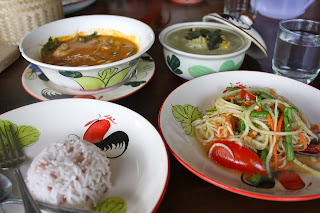 It’s winter. I get it. I should be posting pumpkin soup recipes and ideas for upcoming cookie exchanges. Well, guess what? I’m not. Deal with it.
It’s winter. I get it. I should be posting pumpkin soup recipes and ideas for upcoming cookie exchanges. Well, guess what? I’m not. Deal with it.Lately I’ve had an overwhelming desire to travel. And I’m not talking about a week in the Caribbean or even two weeks in Europe. That’s not gonna cut it. I long for my backpacking days and fantasize about future expeditions: Hiking Machu Picchu, spending a month in an ashram in India, riding a camel through the Sahara. The list goes on.
But nothing is ever like your first time—landing in an unfamiliar city, toting an oversized backpack, ears open to foreign languages, eyes open to foreign sights. The smell from street stalls filling your nose.
This was Bangkok for me in May 2011. Sweat dripping from my every pore, shirt suctioned to my body, horns honking, people running into me from every angle. I loved every minute of it. And that love and excitement continued for the next three months.
That’s why this recipe is so dear to my heart; and probably why I’ve been craving it even during the holiday season.
Vietnamese spring rolls are found, in some variation, all throughout Southeast Asia. Served cold, these handheld wraps are refreshing, fresh and healthy.
Don’t wait for summer. Make them now. Close your eyes and imagine your own backpacking adventure. If you’re anything like me, it’ll satisfy your itchy feet. If only for a night.
 Vietnamese Spring Rolls
Vietnamese Spring Rolls(Makes 8)
Ingredients:
2 ounces rice vermicelli
8 rice wrappers
24 medium cooked shrimp (peeled and deveined)
3 Tbsp chopped fresh basil
3 Tbsp chopped fresh mint
3 Tbsp chopped fresh cilantro
2 romaine lettuce leaves, chopped
2 Tbsp hoisin sauce
1 Tbsp fish sauce (or soy sauce)
1 Tbsp soy sauce
1/2 lime
2 Tbsp peanut butter
1 Tbsp finely chopped peanuts
1 Tbsp peanut oil
Method:
1. Place shrimp in a bowl and mix with the hoisin sauce and fish sauce (or soy sauce). Bring a medium saucepan of water to a boil and boil rice vermicelli 3-5 minutes, or until al dente and drain. Leave to cool.
2. Put peanut oil into skillet and turn burner on medium high heat. Cook shrimp for about 3-5 minutes until pink. Transfer to plate immediately after so they do not overcook. Let cool.
3. Fill the skillet with warm water. Dip one wrapper into the water for 1-2 seconds to soften. Lay the wrapper flat and place 4 shrimp in a row across the center. Place a handful of vermicelli on top, with a handful of the basil, mint, cilantro and lettuce, leaving about 2 inches on each side. Fold the sides over and tightly roll the wrapper. This will take time to perfect! Be patient ☺
4. In a small bowl, mix the lime juice, peanut butter, soy sauce and peanuts. Play around with the combination until you like the texture and taste. Feel free to try hoisin sauce as well.
5. Serve the spring rolls with the dipping sauce and enjoy!









































